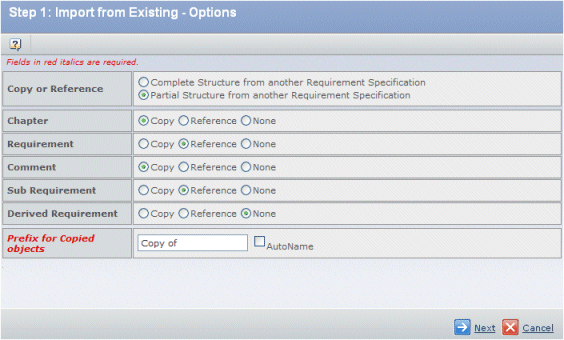Specifying Import Options
From the page
Actions menu, select Import Existing Structure.

Click Complete Structure from another Specification
to import a complete structure.
Or
Click Partial Structure from another Specification
to import a partial structure, allowing you to select the objects (Chapters,
Requirements, etc.) for import.
Specify whether to Copy or just Reference
the following objects from an existing structure: Chapter,
Requirement, Comment, Sub Requirement, or Derived Requirement.The None option ignores the object type when importing.
If you choose to copy, the types, policies, and vault of the copied
objects will be the same as the original object. Each of the copied object's
state will be its first state in the policy as if it were a new object.
For copied objects only, type the Prefix for Copied Objects
or select Autoname.
A prefix is required for copied objects in order to ensure all objects
in the database have a unique name. If Autoname
is selected, the system will assign the prefix. The maximum number of
times that a prefix can be applied is defined by the admin property "emxRequirements.CloneTypes.attempts"
in the emxRequirements.properties file. If name collision cannot be resolved
when this maximum number is reached, autonaming will be used to create
a copy of the object to be imported, in order to avoid extremely long
names.
Click Next.

Choosing the Specification
Use the Search page to find the specification.
Select a Specification to copy/reference its complete or partial structure.
If you are importing a complete structure, click Done.
If specified, all chapters, comments, requirements, and sub and derived requirements will either be copied or referenced.
For a copy, the types, policies, and vault of the copied objects will
be the same as the original objects. Each copied object will be in its
first state in the policy as though it were a new creation.

Choosing Objects for Importing a Partial Structure
If you chose to import a partial structure, you see the Search page for locating objects.
Select the objects you want to import. You may expand and collapse parent
objects with children.
Selected objects are highlighted in a light blue color.
Only the selected branch in the structure defined by the currently
selected List Filter (expansion filter) will be imported. For example,
"Non-functional requirements" will not be imported when the "Functional
Requirements Only" filter is selected.
For Requirements and Comments, there are no expansion vs. collapsed
states since they have no children. Chapters can be expanded or collapsed
since they can contain sub-chapters, requirements, and comments. For
example, if you select a collapsed Chapter, all the children in the branch
will be selected and imported (copied or referenced). If you expand this
chapter, you will see that all the children in this chapter are automatically
selected.
A more complex case is the partial selection of a Chapter branch.
Two use cases can lead to the partial selection:
- If you select a Requirement or Comment in a Chapter structure that is
2 levels deep, the entire parent hierarchy has to be imported to preserve
the structure: the parents of this selected object until the root specification
will be automatically selected. Since this is a third state of selection
(partial) as opposed to a selected (complete), the row will be highlighted
in an orange color to indicate that a partial branch of the Chapter is
selected.
- If you select a Chapter (causing all children to be automatically
selected) but then you unselect one or more children. This is a partial
selection and the row color of the Chapters that have partial selections
will be changed.
Click Done.
|